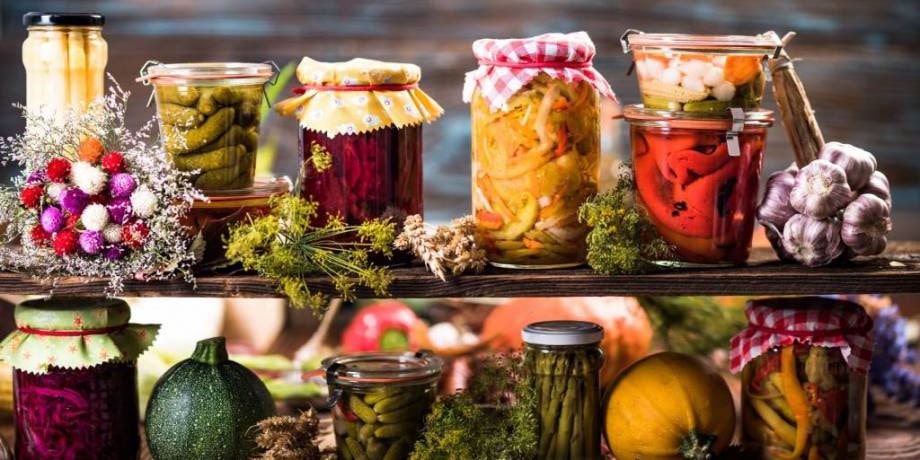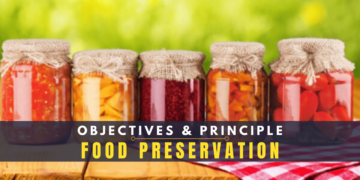This article is very important to read If you want to be a Chef or You are Interested in Kitchen, Cookery and anything related to Food. You must learn the Objectives & Principle Of Food Preservation.
Well, The main Objectives & Principle of food processing on a home scale, institutional scale, or in the food industry are similar, and comprehensively mentioned in this amazing article of the Objectives & Principle Of Food Preservation.

The Objectives of Food Preservation
👉🏻 Removal of unwanted matter from food
Unwanted matters may be inedible, indigestible or harmful to health, such as husk from grain, the skin of some vegetables, coconut shells, etc.
The unwanted matter has to be removed by a different process including shelling, milling, peeling etc.
👉🏻 Making food safe for consumption
Some food contains natural toxins which need to be inactivated, i.e. trypsin inhibitor in soya bean, fungal toxin such as aflatoxin in groundnut & grains, infected portions of food materials, green portion of potato is removed by visual examination, & chemical toxin & poison are discarded.
Ensure the safety of food by using a process to remove toxins & heat to develop microorganism& their toxins. Safe processing prevents contamination.
👉🏻 Increased digestibility
Most foods are difficult to digest unless they are cooked.
Cooking softens fibre, gelatinized starch, denatures protein, & makes food easier to digest. Foods need special kind of processing for preservation.
👉🏻 Enhance flavour colour & taste
The acceptability of food depends on its organoleptic qualities. Processing techniques enhance the appearance of food & many techniques make food more tasteful.
The browning crust is formed due to Miller reaction which gives bakery items its baked flavour aroma & taste. Processing such as caramelization; fermentation etc gives food a different flavour.
👉🏻 Improving texture & consistency
Processes such as emulsification, gel formation & increase in viscosity are aimed to improve the texture & consistency of ready to eat food.
👉🏻 Minimized nutrients loss
Nutrition is better retained by controlled processing conditions such as autoclaving, freezer drying & controlled heat. Nutrients loss due to processing is managed by adding extra vitamins.
Processed margarine, butter, etc are fortified by vitamins. Other processed food often enriched with vitamins, minerals & lysine.
👉🏻 Extending the self-life
Processing extends the self-life because apart from removing unwanted, spoilt & harmful matter & subjecting the food to temperatures outside the danger zone, all processes such as dehydration, cold storage, canning & pasteurization are aimed at preservation to food.
👉🏻 Increased acceptability through fabricated foods
New products of uniform sizes & shape are been introduced in the market. They are made from low-grade commodities which are plentiful or good for health.
The Principle of Food Preservation
1. Preservation or delay of microbial decomposition : That is archived by…
2. Keeping out microorganisms (asepsis)
3. Removal of microorganisms. i.e. by filtration
4. Hindering the growth of activity of microorganisms. i.e. by low temperature, drying, anaerobic conditions & Killing the microorganisms. i.e. by heat or radiations.
5. Preservation or delay by self – decomposition of food. This is brought about by…
6. Destruction or inactivation of food enzymes. i.e. by blanching
7. Preservation or delay of chemical reactions i.e. preservation of oxidation by means of an antioxidant.
8. Preservation of damage caused by insects, animals & mechanical causes.
Top 03 Trending articles from Hospitality Connaisseur – India.
- 5 Challenges And Problems of Indian Tourism every Hotelier must know
- What Basic Knowledge a Hotel Management Trainee must possess?
- Everything You Need to Know about Night Auditing Process: A Complete Guide.
Do Check out Our Keynote Courses of Front Office, Housekeeping, Food & Beverage Service, Hotel Law, Food Production and Human Resource Management. Start Reskilling & Upskilling Today. Develop niche skills and make yourself ready for ‘New Normal’. CLICK HERE to know more!





























